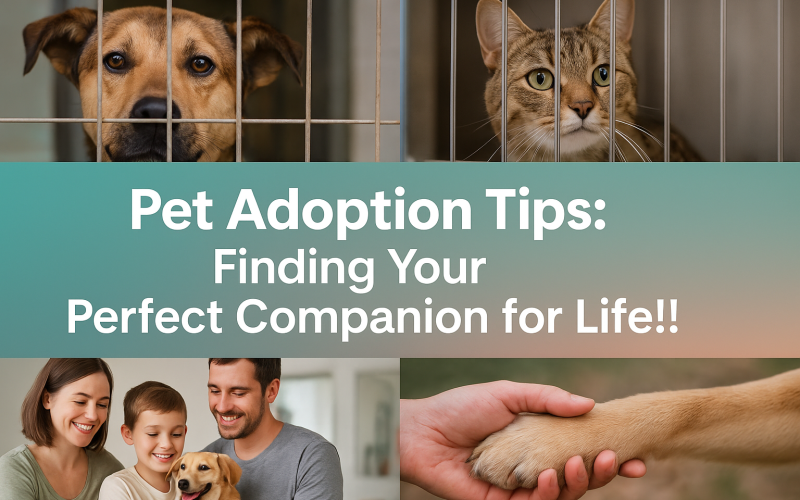Introduction
Welcoming a pet into your life is more than a feel‑good moment at the shelter. It is a promise that lasts ten to twenty years, shaping your daily routine, travel plans, and even your budget. The right match delivers endless affection, health benefits, and joyful memories. The wrong match can strain finances and emotions for both guardian and animal. This guide walks you through every step of pet adoption, helping you find a companion who fits your lifestyle today and tomorrow. By the end, you will know how to select, welcome, and support a new family member with confidence.
What Is Pet Adoption and Why It Matters
Adoption means taking an animal from a rescue, shelter, or foster network rather than buying from a breeder or pet store. Shelters house pets of every age, size, and personality—often surrendered for reasons unrelated to behavior. Choosing adoption eases overcrowded facilities, reduces euthanasia, and rewards you with a grateful friend. In many regions, adoption fees also cover vaccinations, microchipping, and spay or neuter surgery, lowering start‑up costs while supporting humane programs.
Preparing Your Home for a New Arrival
Before visiting a shelter, inspect your living space. Dogs need secure yards or nearby parks; cats require quiet corners and climbing spots. Small pets such as rabbits or guinea pigs demand chew‑safe wiring and escape‑proof pens. Store cleaning agents and houseplants like lilies or philodendrons in cabinets because they can poison curious animals. Finally, purchase essentials—bed, bowls, litter box, carrier—so the new pet arrives to a ready home, reducing stress on both sides.
Choosing the Right Species and Breed

Your daily rhythm, energy level, and housing rules guide this choice. A high‑rise studio may suit a calm adult cat, while a suburban jogger might prefer a medium‑sized dog that enjoys distance runs. If allergies worry you, consider poodle mixes or hairless cats, but meet them first; no breed is fully hypoallergenic. People who travel often or work long shifts could explore low‑maintenance fish or hamsters, which tolerate solo time better than dogs.
Dogs: Diverse and Demanding
Puppies charm hearts but need house‑training and socialization classes. Senior dogs often arrive house‑broken and grateful for gentle walks. Herding breeds such as border collies crave mental tasks, whereas greyhounds enjoy short sprints followed by long naps.
Cats: Independent Yet Social
Kittens play nonstop and may scratch furniture without proper outlets. Adult cats reveal settled personalities at shelters, making temperament easier to judge. Long‑haired breeds demand weekly brushing to avoid mats; short‑haired cats shed but require less grooming.
Small Mammals, Birds, and Reptiles
Rabbits bond closely but chew wires, so supervise free‑range time. Parrots live decades and need daily enrichment to prevent feather plucking. Tortoises are quiet and hypoallergenic yet need specialized UV lighting and spacious enclosures.
Assessing Shelter Pets

Spend time in meet‑and‑greet rooms. Observe body language: relaxed ears and a wagging or gently swishing tail signal comfort. Ask staff for medical and behavioral notes, including reactions to children or other pets. Request to walk a dog outside the kennel; stress often masks true demeanor inside noisy rows. For cats, offer a feather wand to see play style and confidence level.
The Adoption Process Step by Step
Shelters usually require an application detailing housing, employment stability, and vet references. Some arrange a home‑check via video call to ensure safe conditions. Once approved, you pay an adoption fee—ranging from $25 for small rodents to $350 for pure‑bred dogs—which covers basic healthcare. Sign a contract agreeing to return the pet to the shelter if unforeseeable issues arise. Many facilities offer post‑adoption support, including training vouchers or discounted vet visits.
First Weeks at Home: Building Trust
Limit the new pet’s roaming area at first. A single room helps cats locate litter boxes and reduces hiding. Dogs thrive on routines; feed, walk, and play at the same times daily. Use positive reinforcement—treats, praise, toys—to reward calm behavior. Schedule a wellness exam within one week to establish baseline health and introduce your chosen veterinarian.
Budgeting for a Lifetime of Care

Food and treats represent only a fraction of long‑term costs. Annual check‑ups, dental cleanings, flea and tick preventives, and emergency care add up. Dogs and cats need updated vaccines every one to three years. Pet insurance can offset surprise expenses; compare policies before health issues develop. Grooming, pet‑sitting, or training classes may also figure into the equation.
Average Monthly Costs by Pet Type
| Pet Type | Lifespan (yrs) | Energy Level | Monthly Essentials Cost* | Best For |
|---|---|---|---|---|
| Adult Cat | 12–18 | Moderate | $60 | Apartment dwellers |
| Medium Dog | 10–14 | High | $90 | Active families |
| Senior Dog | 8–12 | Low | $75 | Retirees, first‑time owners |
| Rabbit | 8–10 | Medium | $50 | Quiet households |
| Parrot | 20–40 | High | $70 | Experienced owners |
| Leopard Gecko | 10–15 | Low | $25 | Allergy‑sensitive homes |
*Essentials include food, routine vet care amortized, basic supplies, and insurance where common.
Training and Socialization Tips

Positive methods build lasting trust. Use clickers or verbal markers to indicate correct behavior, followed by immediate rewards. Short, frequent sessions—five minutes, three times a day—beat marathon drills. Socialize puppies before sixteen weeks by exposing them to varied sights, sounds, and people. Adult rescues still learn; enroll in basic obedience or employ puzzle feeders to challenge minds. Cats enjoy clicker training too—teach “sit” or “high five” to boost confidence and curb boredom.
Common Challenges and Solutions
Separation Anxiety
Gradually lengthen departures, leaving treat‑filled toys to occupy minds. Calming pheromone diffusers can ease tension for both dogs and cats.
House‑Soiling
Rule out medical causes with a vet visit. Reinforce litter habits by cleaning boxes daily or increase potty breaks for dogs. Reward eliminations outdoors or in litter, never punish accidents.
Allergies
Frequent vacuuming with HEPA filters and wiping pets with damp cloths remove dander. Consult allergists for immunotherapy shots if symptoms persist.
Long‑Term Commitment and Lifestyle Changes
Pets age faster than humans, requiring dietary tweaks, joint supplements, or ramps for stairs. Plan for life events—moves, job shifts, new babies—by researching pet‑friendly housing and seeking support networks. Create pet guardianship plans in wills; shelters sometimes offer “pet legacy” programs ensuring continued care if guardians pass away.
Conclusion
Adopting a pet blends careful planning, honest self‑assessment, and ongoing commitment. By evaluating species and breed traits, preparing your home, budgeting responsibly, and addressing challenges with patience, you transform rescue into lifelong companionship. The reward is mutual: a safe, loving environment for the animal and daily joy for you—proof that a thoughtful adoption truly saves two lives, theirs and yours.
Call to Action
Ready to find your perfect companion? Visit local shelters this weekend, bring these tips along, and talk with adoption counselors about matches that fit your lifestyle. Share your journey online to inspire others and help even more pets find loving homes.










